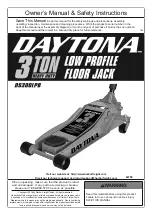
TANK TRACK PULLER AND PUMP END CONNECTOR HYDRAULIC JACK
MODEL NO: 24
-
52701 NSN: 5120
-
01
-
052
-
5642
OPERATING PRESSURE: 8,000 PSI PROOF PRESSURE: 12,000 PSI
PRODUCT INFORMATION
INSTRUCTION & PARTS SHEET
REV 2/21
GENERAL INSTRUCTIONS
To assure long and dependable performance of your
hydraulic tools, the following precautions should be ob-
served:
1.
Be sure that all units are wiped clean before and
after using. A light grade of oil should be use on
moving parts to prevent rusting and prolong life.
2.
Make sure that all attachments are fully tightened.
3.
When not in use, ram and pump piston should be
fully retracted and release valve closed. Connecting
openings to tools should be plugged to prevent en-
trance of foreign matter.
4. Refill only with MIL
-
PRF
-
83282 Hydraulic Jack Oil.
OPERATING INSTRUCTION—SET UP
Attach hose from pump to puller and position as shown
in illustration. Puller may be in either a horizontal or ver-
tical position and release. Close release valve when
ram is fully retracted and units are ready for use.
BLEEDING AIR FROM THE SYSTEM
During the initial moments of activation or after prolonged
use a significant amount of air may accumulate within the
hydraulic system. This entrapped air may cause the cyl-
inder to respond slowly or behave in a unstable manner.
To remove the air, run the system through several cycles
(extending and retracting the pusher pin) free of any load.
Make certain the end connector puller is at a lower level
than the pump to allow air to be released through the
pump reservoir. Once all the air has been bled from this
system, inspect the oil and replenish the reservoir if nec-
essary.
INSPECTING THE HYDRAULIC FLUID LEVEL
Always retract the pusher ram completely before at-
tempting this procedure.
Check the oil level in the reservoir after approximately
every ten hours of use. Place the pump in a vertical posi-
tion with the pump head facing downward. Unscrew and
remove the filler screw from the reservoir. The oil level
within the reservoir should come to the filler screw hole
on the reservoir body.
TO DISASSEMBLE—PULLER
1.
Remove plug #2
-
53990
2.
Remove roll pin #2
-
54799
3.
Unscrew cap #56144
4.
Remove push pin block #2
-
54679
5.
Unscrew ram cylinder # 2
-
54802
6.
Slide out ram #56126 toward puller arm
7.
Replace worn parts and reassemble in reverse order
REPAIR KIT
Hand Pump —
5
-
1100
Puller—
5
-
1101
REPAIR GUIDE
PROBLEM
CAUSE
SOLUTION
PUMP NOT DELIVERING OIL
1. Low oil in reservoir
Check oil level per instructions
2. Dirt in pump body
Disassemble pump body and clean all parts
3. Seats worn and not seating properly
Reseat required seats in casting
4. Reservoir overfilled with oil
Check oil level per reservoir instructions
5. Vacuum Bound
Loosen filler screw on reservoir
PUMP LOSING PRESSURE
1. Oil leaking past outlet ball seat(s)
Reseat ball seat(s)
2. Pressure control knob leaks, not adjusted properly
Reseat pressure control assembly & replace assembly
PUMP DOES NOT REACH FULL PRESSURE
1. Low oil level
Check oil level per reservoir instructions
2. Relief valve set to low
See relief valve adjustment instructions
3. Reservoir overfilled with oil
Check oil level per reservoir instructions
HANDLE RAISES AFTER EACH STROKE
1. Oil leaking past outlet ball
Replace ball and/or reseat
PUMP HANDLE CAN BE PUSHED DOWN (SLOWLY) WITHOUT RISING THE LOAD
1. The inlet ball is not seating
Check for dirt and/or reseat valve seat
PUMP HANDLE OPERATES WITH SPONGY ACTION
1. Air has been trapped in the line
Set tank end connector tool lower than the pump and extend and
return pusher pin serval times
2. Reservoir overfilled with oil
Check oil level reservoir instructions.
SAFETY PRECAUTIONS
•
Before operating the pump, make sure all hose connections are tight—use the proper tools to tighten connections.
•
Do not overtighten the connections. Connections need only be tightened securely and leak
-
free. Overtightening may
cause premature thread failure or high pressure fittings to split at pressures lower than their rated capacities.
•
Open pressure control knob to release all system pressure before loosening any hydraulic connection in the system.
•
Should a hydraulic hose ever burst or rupture, immediately shut off the pump. Never attempt to grasp a leaking hose un-
der pressure with your hands. The force of the escaping hydraulic fluid could cause serious and permanent injury.
•
Avoid any conditions which could damage the hose and impair the pump
’
s performance. Never allow the hose to kink,
twist, curl or bend so tightly that the oil flow within the hose is blocked or reduced. This could damage the hose and
possibly result in serious injury to persons working in the immediate vicinity.
•
Do not use the hose to lift or move the equipment connected to it. Periodically inspect the hose for signs for wear. Never
use a defective hose with any pressurized equipment.
•
Hose material and coupler seals must be compatible with the hydraulic fluid use.
PUMP
•
Never exceed the 12,000 PSI hydraulic Proof Pressure rating. Safety Relief Valve is set at 7,330 PSI at factory.
•
Never overfill the pump reservoir with oil. Always retract the system before replenishing the oil level.
















